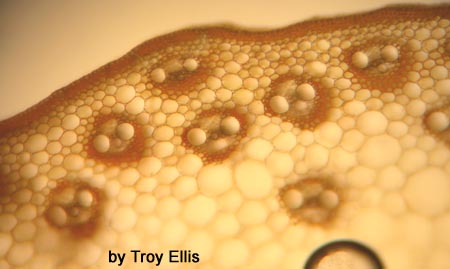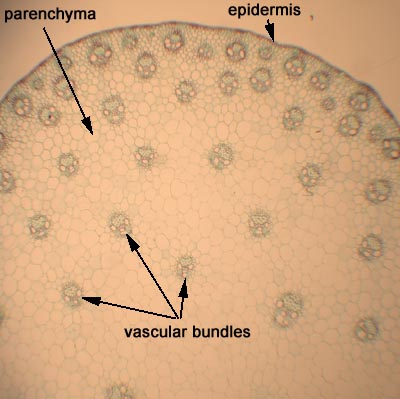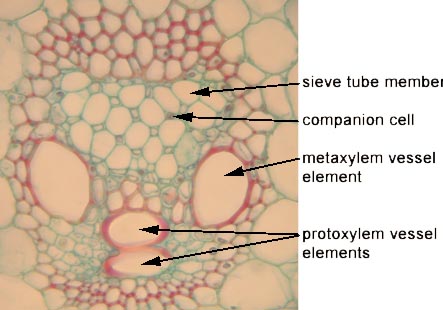4. MONOCOT STEMS
In most monocots the vascular bundles are discrete and scattered throughout the ground tissue (atactostele), rather than arranged in a single ring. This type of arrangement is called an atactostele. Consequently there is not a distinguishable cortex and pith.
Here is a close look at one of the bundles. Can you distinguish the primary xylem from the primary phloem?
This is a section through the older stem of corn. Hmmmmm….looks pretty darn similar……what is the point????? Well…even in the older stem there is no secondary growth! In fact one of the main characteristics of the monocots is that they never produce vascular cambium.
Here is picture of a vascular bundle. Locate the phloem, and identify the sieve tubes and companion cells. The two large vessels located next to the phloem are functional metaxylem vessels. The protoxylem is no longer intact, nor functional, as it is differentiated in the young stem and destroyed by elongation as the stem matures. All that remains of it is an air space and, sometimes, fragments of the lignified thickenings. See Raven 7th, p.557, Fig. 25-13; 8th, p.589, Fig. 25-14.
Monocot “Wood”
Many monocots achieve great heights. These include such examples as palm trees and Joshua trees (pictured here).
How can arborescence occur without secondary growth? These monocots do not produce a true vascular cambium (a layer of cells which produces phloem toward the outside and xylem toward the inside). Instead we see a layer of cells which gives rise to entire vascular bundles.
There are special terms for how the tissue is arranged in a vascular bundle. This is an example of an amphivasal type of arrangement where the xylem surrounds the phloem. The examples you have seen thus far have been collateral, that is the phloem occurs on one side of the xylem. How many other other arrangements can you think of? (Other terms to know are: bicollateral, amphicribal)
3. PRIMARY TO SECONDARY GROWTH
4. MONOCOT STEM







